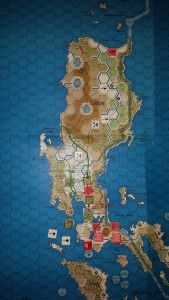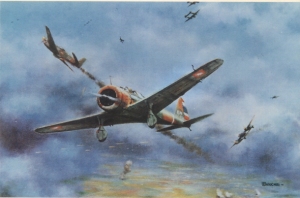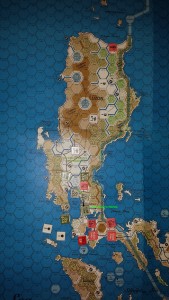TDDH: Feb I 42: The Allies
I had to pull the original post because I made an error that changed the outcome of the turn and had to redo it. I’m sure there are a large number of people out there who believe I’m an idiot, and there is some credence to that thought. The B-17s can fly from Australia to Clark Field, but they were supposed to stop there. Instead, I applied the Europa staging rule.
I need to clarify what I said in my last post about the Japanese winning on victory points.
Victory points have only been tabulated based on enemy losses, not territorial objectives. These are not tabulated until the end of the game. However, it appears that only the Japanese may gain victory points based on territorial gains. In other words, the only way for the Allies to win is to drive the Japanese off the islands altogether. For the record, the Japanese have an additional 92 victory points based on these territorial objectives.
Things are finally rolling in the right direction for the Allies. The Japanese have been forced to more or less abandon northern Luzon. They have no bomber air support, and Manila is still in Allied hands. But simply holding Manila is not going to win the campaign for the Allies. They must figure out a way to drive the Japanese from Luzon. Time, in my opinion, is no longer on the side of the Allies. By this I mean, no more American reinforcements are forthcoming, and replacements are minimal. They cannot wage a war of attrition (although this has been very successful in whittling down Japanese strength).
However, there are still several options open to the Allies.
- Recapture the ports on the north end of Luzon. This will have little effect on the Japanese, and probably only move critical forces out of position.
- Withdraw to Mariveles and prepare Corregidor for a siege.
- Move across Manila Bay and reinforce Manila. This move will most likely hold the Japanese off from a complete capture of Luzon (I think) but does not win the Battle of the Philippines for the Allies.
- Attack the wounded Japanese forces north of Manila, and attempt to eliminate them as well.
- Evacuate to Mindanao, to the south where there is more defensible terrain and greater room to operate.
- Evacuate to Cebu City, which keeps open a naval base, but the terrain is not the most defensible.
The question is, which is the best path? The central islands are pretty much indefensible, due to their small size and lack of defensive terrain. Holding Manila means that every month, resource points are still produced. Holding Cebu means the naval base stays open, but the remains of the American fleet are hemmed in at Manila Bay, and must still make it past the minefield, and then the Japanese fleet lurking on the southern end of Luzon (which evacuating forces from Luzon must still somehow sneak past).
Withdrawing to Bataan could be a good move (and kind of boring and predictable), but may be a bit premature.
The Allies receive a pair of B-17E bomber squadrons in Australia, one ready to go, and the other, apparently, without engines and not going anywhere.
This is also the beginning of the Filipino army receiving infantry replacements on the I turn of each month, based on what cities are Allied held.
Luzon
The armor replacement point that arrived in Manila at the end of January is used to upgrade the US cavalry regiment into a 3-10 mechanized battalion, and another resource point is produced at Manila.
The Japanese 16th corps was decimated last turn, and the opportunity to destroy it has presented itself. Of course, it isn’t going to be easy and it is possible that if the Allies fail, the battle for Luzon is all but over.
The 16th corps is composed of artillery, construction units, a decimated infantry division, and a light infantry regiment. The Japanese have a total of 20 defense factors in the corps. In order to reach 3:1 odds, the Allies have to be able to get 60 attack factors attacking the hex. Unfortunately, the Allies don’t have that kind of offensive strength. Instead, the Allies are going have to muster 40 attack factors in order to achieve a 2:1 attack, which is achievable, but is also very risky. Even getting the minimal 1/7 AEC is going to be very tricky, but doable.
Even if the Allies achieve a 2:1 attack, they are most likely going to suffer casualties in the attack. Oh for want of an armored division!
The Filipino 2nd infantry division leaves Manila and pushes north into Malolos, accompanied by the newly upgraded US mechanized battalion and a pair of artillery units. To the west, the US Philippines infantry division pushes southeast into the rice fields, while the US light armor cadre moves south from San Fernando to hook up with the Filipino 1st infantry cadre just south of Cabanatuan to attack from the north. Meanwhile, the Filipino 1st artillery regiment moves down the road and into the rice fields to join the US infantry division.
Two Filipino brigades cross the Pampanga River and into the swamps to close the gap in the line. They will not be participating in the attack, however.
Attacking the Japanese:
- US Philippines Division (12-6; 3RE)
- 2nd Filipino infantry division (9-11-6 unsupported; 3RE)
- 1PGp armor cadre (6-5-10 supported; 1RE)
- 26 PSr US mechanized battalion (3-10; 1/2 capability for AEC purposes)
- 301st Filipino artillery regiment (3-6; neutral for AEC (not counted))
- US 148th artillery regiment (1-2-8; neutral for AEC (not counted))
- US 1PSr artillery battalion (0-1-8; for support purposes only; neutral for AEC (not counted))
Total attack strength for the Allies: 34. A few attack factors short of the needed 40, so air support needs to be called in.
Before that, however, we must figure out armor effects. The minimum is 1/7 (.143). The Allies are attacking with 1.25/7.5, which gives them a total of .166, just barely greater than the needed 1/7. The Allies gain a +1 DRM to this attack.
The B-17Es that just arrived in Australia take off from Darwin on a transfer mission, landing in the SW Celebes (Japanese controlled next turn) to refuel, then on to Cagayan, where it again refuels. From Cagayan, it flies to Clark Field where it becomes inoperative and cannot participate in the attack.
The squadron gives a wide berth to the fighters on southern Luzon.
Three bomber squadrons, escorted by two P-40E squadrons fly ground support in the combat hex. Nine REs means that up to 4 bomber squadrons can fly support. The ground support only adds 4 points to the attack, and the Allies fall short of the required 40 attack factors needed for a 2:1 attack.
However, the Japanese decide to intercept. What the hell, why not?
Amazingly enough, one of the KI-27b fighters scores a kill on one of the P-40s (snake eyes!), while the escorts only force the return of one of the interceptors. An incredible outing for the Japanese, although it does not stop the mission.
The attack goes off at 1.5:1, +1 DRM for armor support. No guts, no glory.
The possible outcomes: Attacker retreat (1 in 6), nothing (attacker stopped) (1 in 3), an exchange of some sort (totally eliminating the Japanese) ( 1 in 3), either half exchange or full exchange, or the Japanese suffer losses without loss to the Allies (defender retreat) (1 in 3).
All that’s really required is to force the Japanese to retreat. The ground units can escape to the NE, across the mountains and into the jungle. However, the artillery can’t escape into the jungle.
Things don’t work out as hoped for the Allies. The attack has no effect as the Japanese hold their ground and repulse the attack: Attacker Stopped.
Meanwhile, the US 803 construction battalion moves to Corregidor with the intention of building a new airfield there. The two Filipino construction battalions remove 2 more hits from Clark Field (leaving 2 hits).
After being repulsed, the units that sallied from Manila return to Manila. The US Philippines division and the Filipino 301st artillery regiment push into Malolos and re-establish contact with Manila.
The Central Islands
The Allies stand pat, with a pair of Filipino infantry battalions returning to Iloilo. Six infantry battalions hold the city, and an infantry brigade holds Cebu City.
Mindanao
Two infantry battalions march across the island from the Malabang airfield operation. A brigade still holds Zamboanga on the tip of the island, but the Allies are not convinced this is the best place to be. They stay put at the port for now, however.
End Turn
That Manila is now producing infantry replacement points every month makes holding the city more important than ever. The Japanese are closing in, and there is going to be a heck of a fight for the city.
I took a gamble attacking the Japanese. In the end, the Allies were not hurt because of it, but they didn’t destroy the Japanese artillery as I had hoped. But contact with the city has been re-established after several weeks of being cut off from it.
The rest of the islands are a different issue, though. Not great terrain, and small, unsupported forces. Cagayan down on Mindanao is in lowlands, and the terrain isn’t the greatest there, either. While I don’t want to just hand victory points over to the Japanese, I’m not sure the meager forces on the central islands can even slow them down. Do I leave them put, or do I send them to Mindanao, to join the other Filipino forces down on Mindanao?



